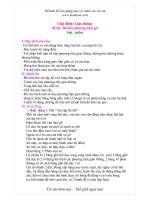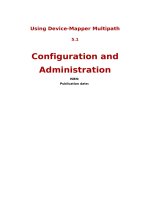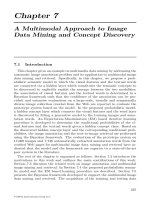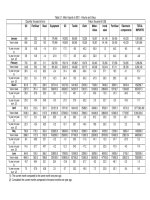Tài liệu CAMELS pptx
Bạn đang xem bản rút gọn của tài liệu. Xem và tải ngay bản đầy đủ của tài liệu tại đây (53.94 KB, 4 trang )
Bank supervisory agencies are responsible for monitoring the financial conditions of commercial
banks and enforcing related legislation and regulatory policy. Although much of the information
needed to do so can be gathered from regulatory reports, on-site examinations are needed to verify
report accuracy and to gather further supervisory information. Much research has explored the
value of this private information, both to the bank supervisors and to the public who monitor banks
through the financial markets.
This Economic Letter selectively surveys this literature, focusing mainly on studies using CAMELS
ratings. These supervisory ratings are assigned at the end of exams and are directly disclosed only
to senior bank management and to the appropriate supervisory personnel. CAMELS ratings are
commonly viewed as summary measures of the private supervisory information gathered by
examiners regarding banks' overall financial conditions, although they also reflect available public
information.
The general consensus in this literature is that the private supervisory information contained in
CAMELS ratings is useful in the supervisory monitoring of banks. Furthermore, to the extent that
this information filters out into the financial markets, it appears to affect the prices of bank
securities. Thus, private supervisory information in CAMELS ratings also appears to be useful in the
public monitoring of banks.
What are CAMELS ratings?
During an on-site bank exam, supervisors gather private information, such as details on problem
loans, with which to evaluate a bank's financial condition and to monitor its compliance with laws
and regulatory policies. A key product of such an exam is a supervisory rating of the bank's overall
condition, commonly referred to as a CAMELS rating. This rating system is used by the three federal
banking supervisors (the Federal Reserve, the FDIC, and the OCC) and other financial supervisory
agencies to provide a convenient summary of bank conditions at the time of an exam.
The acronym "CAMEL" refers to the five components of a bank's condition that are assessed: Capital
adequacy, Asset quality, Management, Earnings, and Liquidity. A sixth component, a bank's
Sensitivity to market risk, was added in 1997; hence the acronym was changed to CAMELS. (Note
that the bulk of the academic literature is based on pre-1997 data and is thus based on CAMEL
ratings.) Ratings are assigned for each component in addition to the overall rating of a bank's
financial condition. The ratings are assigned on a scale from 1 to 5. Banks with ratings of 1 or 2 are
considered to present few, if any, supervisory concerns, while banks with ratings of 3, 4, or 5
present moderate to extreme degrees of supervisory concern.
All exam materials are highly confidential, including the CAMELS. A bank's CAMELS rating is directly
known only by the bank's senior management and the appropriate supervisory staff. CAMELS
ratings are never released by supervisory agencies, even on a lagged basis. While exam results are
confidential, the public may infer such supervisory information on bank conditions based on
subsequent bank actions or specific disclosures. Overall, the private supervisory information
gathered during a bank exam is not disclosed to the public by supervisors, although studies show
that it does filter into the financial markets.
CAMELS ratings in the supervisory monitoring of banks
Several academic studies have examined whether and to what extent private supervisory
information is useful in the supervisory monitoring of banks. With respect to predicting bank failure,
Barker and Holdsworth (1993) find evidence that CAMEL ratings are useful, even after controlling
for a wide range of publicly available information about the condition and performance of banks.
Cole and Gunther (1998) examine a similar question and find that although CAMEL ratings contain
useful information, it decays quickly. For the period between 1988 and 1992, they find that a
statistical model using publicly available financial data is a better indicator of bank failure than
CAMEL ratings that are more than two quarters old.
Hirtle and Lopez (1999) examine the usefulness of past CAMEL ratings in assessing banks' current
conditions. They find that, conditional on current public information, the private supervisory
information contained in past CAMEL ratings provides further insight into bank current conditions, as
summarized by current CAMEL ratings. The authors find that, over the period from 1989 to 1995,
the private supervisory information gathered during the last on-site exam remains useful with
respect to the current condition of a bank for up to 6 to 12 quarters (or 1.5 to 3 years). The overall
conclusion drawn from academic studies is that private supervisory information, as summarized by
CAMELS ratings, is clearly useful in the supervisory monitoring of bank conditions.
CAMELS ratings in the public monitoring of banks
Another approach to examining the value of private supervisory information is to examine its impact
on the market prices of bank securities. Market prices are generally assumed to incorporate all
available public information. Thus, if private supervisory information were found to affect market
prices, it must also be of value to the public monitoring of banks.
Such private information could be especially useful to financial market participants, given the
informational asymmetries in the commercial banking industry. Since banks fund projects not
readily financed in public capital markets, outside monitors should find it difficult to completely
assess banks' financial conditions. In fact, Morgan (1998) finds that rating agencies disagree more
about banks than about other types of firms. As a result, supervisors with direct access to private
bank information could generate additional information useful to the financial markets, at least by
certifying that a bank's financial condition is accurately reported.
The direct public beneficiaries of private supervisory information, such as that contained in CAMELS
ratings, would be depositors and holders of banks' securities. Small depositors are protected from
possible bank default by FDIC insurance, which probably explains the finding by Gilbert and Vaughn
(1998) that the public announcement of supervisory enforcement actions, such as prohibitions on
paying dividends, did not cause deposit runoffs or dramatic increases in the rates paid on deposits
at the affected banks. However, uninsured depositors could be expected to respond more strongly
to such information. Jordan, et al., (1999) find that uninsured deposits at banks that are subjects of
publicly-announced enforcement actions, such as cease-and-desist orders, decline during the
quarter after the announcement.
The holders of commercial bank debt, especially subordinated debt, should have the most in
common with supervisors, since both are more concerned with banks' default probabilities (i.e.,
downside risk). As of year-end 1998, bank holding companies (BHCs) had roughly $120 billion in
outstanding subordinated debt. DeYoung, et al., (1998) examine whether private supervisory
information would be useful in pricing the subordinated debt of large BHCs. The authors use an
econometric technique that estimates the private information component of the CAMEL ratings for
the BHCs' lead banks and regresses it onto subordinated bond prices. They conclude that this aspect
of CAMEL ratings adds significant explanatory power to the regression after controlling for publicly
available financial information and that it appears to be incorporated into bond prices about six
months after an exam. Furthermore, they find that supervisors are more likely to uncover
unfavorable private information, which is consistent with managers' incentives to publicize positive
information while de-emphasizing negative information. These results indicate that supervisors can
generate useful information about banks, even if those banks already are monitored by private
investors and rating agencies.
The market for bank equity, which is about eight times larger than that for bank subordinated debt,
was valued at more than $910 billion at year-end 1998. Thus, the academic literature on the extent
to which private supervisory information affects stock prices is more extensive. For example,
Jordan, et al., (1999) find that the stock market views the announcement of formal enforcement
actions as informative. That is, such announcements are associated with large negative stock
returns for the affected banks. This result holds especially for banks that had not previously
manifested serious problems.
Focusing specifically on CAMEL ratings, Berger and Davies (1998) use event study methodology to
examine the behavior of BHC stock prices in the eight-week period following an exam of its lead
bank. They conclude that CAMEL downgrades reveal unfavorable private information about bank
conditions to the stock market. This information may reach the public in several ways, such as
through bank financial statements made after a downgrade. These results suggest that bank
management may reveal favorable private information in advance, while supervisors in effect force
the release of unfavorable information.
Berger, Davies, and Flannery (1998) extend this analysis by examining whether the information
about BHC conditions gathered by supervisors is different from that used by the financial markets.
They find that assessments by supervisors and rating agencies are complementary but different
from those by the stock market. The authors attribute this difference to the fact that supervisors
and rating agencies, as representatives of debtholders, are more interested in default probabilities
than the stock market, which focuses on future revenues and profitability. This rationale also could
explain the authors' finding that supervisory assessments are much less accurate than market
assessments of banks' future performances.
In summary, on-site bank exams seem to generate additional useful information beyond what is
publicly available. However, according to Flannery (1998), the limited available evidence does not
support the view that supervisory assessments of bank conditions are uniformly better and more
timely than market assessments.
Conclusion
The academic literature effectively shows that CAMELS ratings, as summary measures of the private
supervisory information gathered during on-site bank exams, do contain information useful to both
the supervisory and public monitoring of commercial banks. A relevant policy question is whether
supervisors might benefit by disclosing CAMELS ratings to the public. Such disclosure could benefit
supervisors by improving the pricing of bank securities and increasing the efficiency of the market
discipline brought to bear on banks. As argued by Flannery (1998), market assessments of bank
conditions compare favorably with supervisory assessments and could improve with access to
supervisory information. However, although supervisors could benefit from such improved public
monitoring of banks, the costs to the current form of supervisory monitoring must also be
considered. For example, if CAMELS ratings were made public, the current information-sharing
relationship between examiners and bankers could change in a way that adversely affects
supervisory monitoring. Further research and debate on this question is currently needed.
Jose A. Lopez
Economist
References
Barker, D., and D. Holdsworth. 1993. "The Causes of Bank Failures in the 1980s." Research Paper
No. 9325, Federal Reserve Bank of New York.
Berger, A.N., and S.M. Davies. 1994. "The Information Content of Bank Examinations." Journal of
Financial Services Research 14, pp. 117-144.
___, ___, and M.J. Flannery. 1998. "Comparing Market and Supervisory Assessment of Bank
Performance: Who Knows What When?" Finance and Economics Discussion Series 1998-32, Federal
Reserve Board of Governors.
Cole, R.A., and J.W. Gunther. 1998. "Predicting Bank Failures: A Comparison of On- and Off-Site
Monitoring Systems." Journal of Financial Services Research 13, pp. 103-117.
DeYoung, R., M.J. Flannery, W.W. Lang, and S.M. Sorescu. 1998. "The Informational Advantage of
Specialized Monitors: The Case of Bank Examiners." Working Paper No. 98-4, Federal Reserve Bank
of Chicago.
Flannery, M.J. 1998. "Using Market Information in Prudential Bank Supervision: A Review of the
U.S. Empirical Evidence." Journal of Money, Credit and Banking 30, pp. 273-305.
Gilbert, R.A., and M.D. Vaughn. 1998. "Does the Publication of Enforcement Actions Enhance Market
Discipline?" Manuscript, Research Department, Federal Reserve Bank of St. Louis.
Hirtle, B.J., and J.A. Lopez. 1999. "Supervisory Information and the Frequency of Bank
Examinations." Federal Reserve Bank of New York Economic Policy Review 5, pp. 1-20.
Jordan, J.S., J. Peek, and E.S. Rosengren. 1998. "The Impact of Greater Bank Disclosure Amidst a
Banking Crisis." Working Paper No. 99-1, Federal Reserve Bank of Boston.
Morgan, D.P. 1998. "Judging the Risk of Banks: What Makes Banks Opaque?" Working Paper No.
98-05, Federal Reserve Bank of New York.









